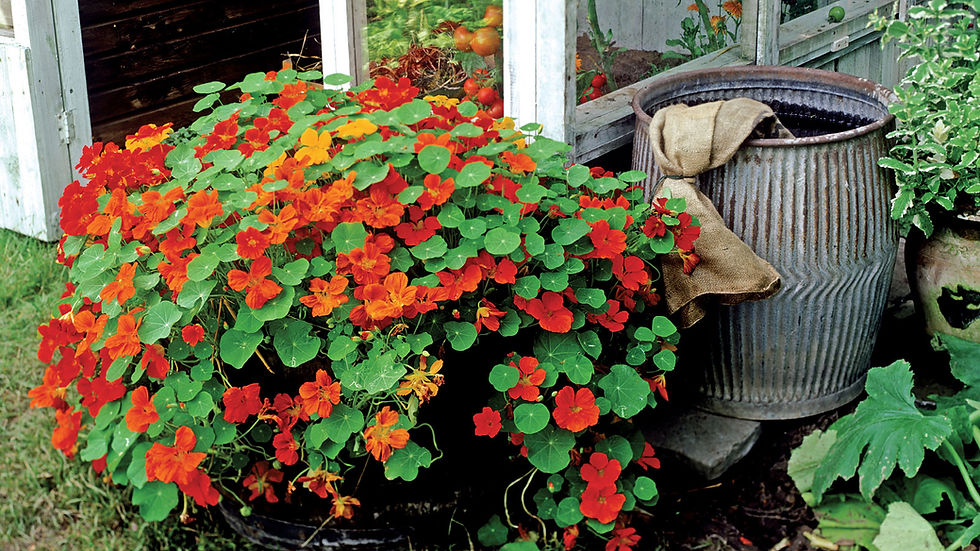Garden Design, more than a pretty landscape!
- Chelsea Watts
- Aug 30
- 3 min read
Garden design isn’t just about what looks aesthetically pleasing, although a garden which is aesthetically pleasing is nice! Garden design, when carefully planned and executed creates a space which is insect and disease free while also protecting against environmental problems like frost, poor ventilation, wind damage and poor drainage.
Common insects that create problems in the garden include but are not limited to: Aphids, Mealy Bugs, Spidermites, White Cabbage Moth, Caterpillars, Fungus Gnats, White Fly and more. If you are like me and don’t like spraying chemicals in your garden, there are plants which can be grown in your garden which reduce the likelihood of common pests.
All avid gardeners know Aphids like roses, and they always show up when your roses are in full flight. Companion planting strong scented crops like garlic, chives, basil, lavender or catnip will confuse Aphids. These strong-smelling crops obscure the Aphids sense of smell and deter them from plants in your garden. Planting flowering herbs and plants like thyme, marigold, calendula and dill will attract ladybugs who will feed on Aphids. Ladybugs also feast on Mealybugs and White Fly making flowering plants an essential addition to the garden.
Tend to weeds regularly not because they look ugly and untidy but because they harbor insects like Spidermites, particularly when conditions are dry. Maintaining a weed free environment, combined with misting watering techniques and co-planting basil and sage should repel Spidermites. White Cabbage Moths love brassicas and if left will make a right royal mess of your brassicas crop(s) and leave you with nothing to harvest. Companion planting nasturtiums will encourage White Cabbage Moths to lay their eggs on them instead of on your brassicas as they are highly attracted to nasturtiums. This makes nasturtiums a decoy plant. Doing this will ensure you won’t have caterpillars hatching out onto and eating your brassicas crop(s). Nasturtiums have a brightly coloured flower, which will beautify your space. The flower is edible, making for an interesting addition to your kitchen.

There is no companion plant which will repel Fungus Gnats but, there are common plants that harbor them. African violets, carnations, cyclamen, poinsettias, ferns and begonia thrive in an environment with consistently moist soil which is the perfect breeding ground for Fungus Gnats. Plant these plants in pots and situate them away from your main garden.
Garden features should always be considered when designing a garden. They reduce the likelihood of pests and diseases but also help combat issues like frost. Dense trees like the mountain ash and other eucalypts trap heat and block winds. Tender plants should be planted in the microclimates these trees create. Utilise mulch to retain heat and separate garden beds to prevent overcrowding. Overcrowding hinders air circulation. Deciduous trees are a great addition to any garden because the time they spend in dormancy allows air to flow through the garden to combat diseases like powdery mildew, gray mold and root rot.
Strong winds cause havoc in the garden! Plant species which are naturally wind resistant; include a mixture of tall trees and dense shrubs. This will allow air through to combat ventilation issues while still creating a wind break. Wind breaks are important because they protect against drying, and damage caused by strong winds.

Lastly, drainage is important to consider when planning a garden. Excess water lying on the ground will cause soil to become waterlogged and will suffocate plants. This deprives plants of oxygen leading to root rot and plant death. To combat this there are several measures you can take, like: building up garden beds, installing land drains, using bark chips for mulch and improving soil structure to ensure water will drain. Heavy clay soils will retain water and should be treated with gypsum and compost to improve its porosity.
Careful planning and continued maintenance will ensure you only need to plant once.



Comments